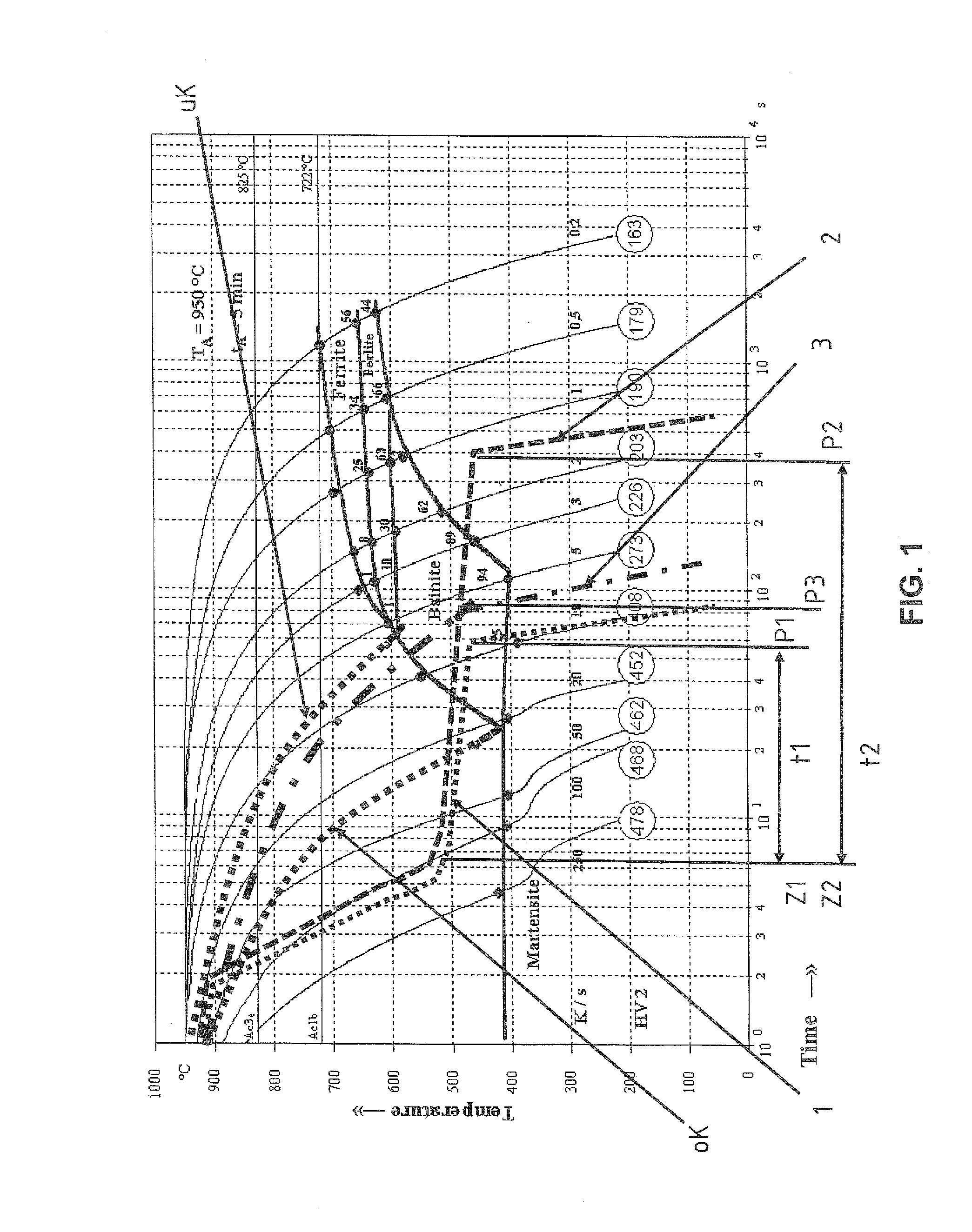Method for producing a hot-formed and press-hardened metal component
a technology of hot-formed and press-hardened metal and automobile parts, which is applied in the direction of heat treatment apparatus, manufacturing tools, transportation and packaging, etc., can solve the problems of long production time of such post-treatment automobile components and relatively high production costs, and achieve the effects of reducing the overall weight of the automobile, low production cost and low weight of the components
- Summary
- Abstract
- Description
- Claims
- Application Information
AI Technical Summary
Benefits of technology
Problems solved by technology
Method used
Image
Examples
first embodiment
[0029]In the illustrated exemplary embodiment, three different curves for different cooling processes are shown. Curve 1 shows the temperature dependence for a first region, which is initially heated to a temperature above the AC3 temperature. The material is then cooled from this temperature to an intermediate temperature of about 520° C. with a cooling speed which in this case is greater than the upper critical cooling speed oK of the illustrated material. When the cooling temperature of the intermediate cooling of above about 520° C. is reached, the first region is isothermally held at a temperature for the time duration t1. The temperature thereby decreases from about 520° C. to about 480° C. due to heat dissipation in form of, for example, heat radiation, convection, but also heat conduction. Accordingly, cooling an austenitic structure is produced at the time Z1 of the intermediate, and a bainitic-austenitic mixed structure at a time P1, corresponding to the start of press-har...
second embodiment
[0031]the method of the invention is illustrated with the cooldown of the first region corresponding to curve 2. The cooldown of curve 2 substantially follows the cooling curve 1, wherein the cooling temperature is held for a longer time from a time Z2 on (equal to Z1), so that the press-hardening process starts at a time P2. Accordingly, the time interval t2 is greater than t1. The structure in the first region is completely transformed into bainite at the time P2, so that no further structural transformation due to the cooling speed takes place after the time P2.
third embodiment
[0032]In a third embodiment according to the present invention, the cooling speed is selected from a temperature above the AC3 temperature according to curve 3, so that the material is during the cooling process of the intermediate cooling transformed directly into the bainitic intermediate structure. In this case, an austenitic-bainitic intermediate structure was adjusted in the first region, so that at the start of the press-hardening process at the time P3 this bainitic-austenitic mixed structure is transformed into a bainitic-martensitic mixed structure in the first region. In the embodiments according to curve 2 and curve 3, the respective second region which is held during the intermediate cooling above the AC3 temperature is transformed directly from the austenitic region into martensite during cooldown in the press-hardening process. According to the invention, the temperature in the embodiment according to curve 3 is selected to be always greater than the lower critical coo...
PUM
| Property | Measurement | Unit |
|---|---|---|
| Temperature | aaaaa | aaaaa |
| Temperature | aaaaa | aaaaa |
| Temperature | aaaaa | aaaaa |
Abstract
Description
Claims
Application Information
 Login to View More
Login to View More - R&D
- Intellectual Property
- Life Sciences
- Materials
- Tech Scout
- Unparalleled Data Quality
- Higher Quality Content
- 60% Fewer Hallucinations
Browse by: Latest US Patents, China's latest patents, Technical Efficacy Thesaurus, Application Domain, Technology Topic, Popular Technical Reports.
© 2025 PatSnap. All rights reserved.Legal|Privacy policy|Modern Slavery Act Transparency Statement|Sitemap|About US| Contact US: help@patsnap.com

